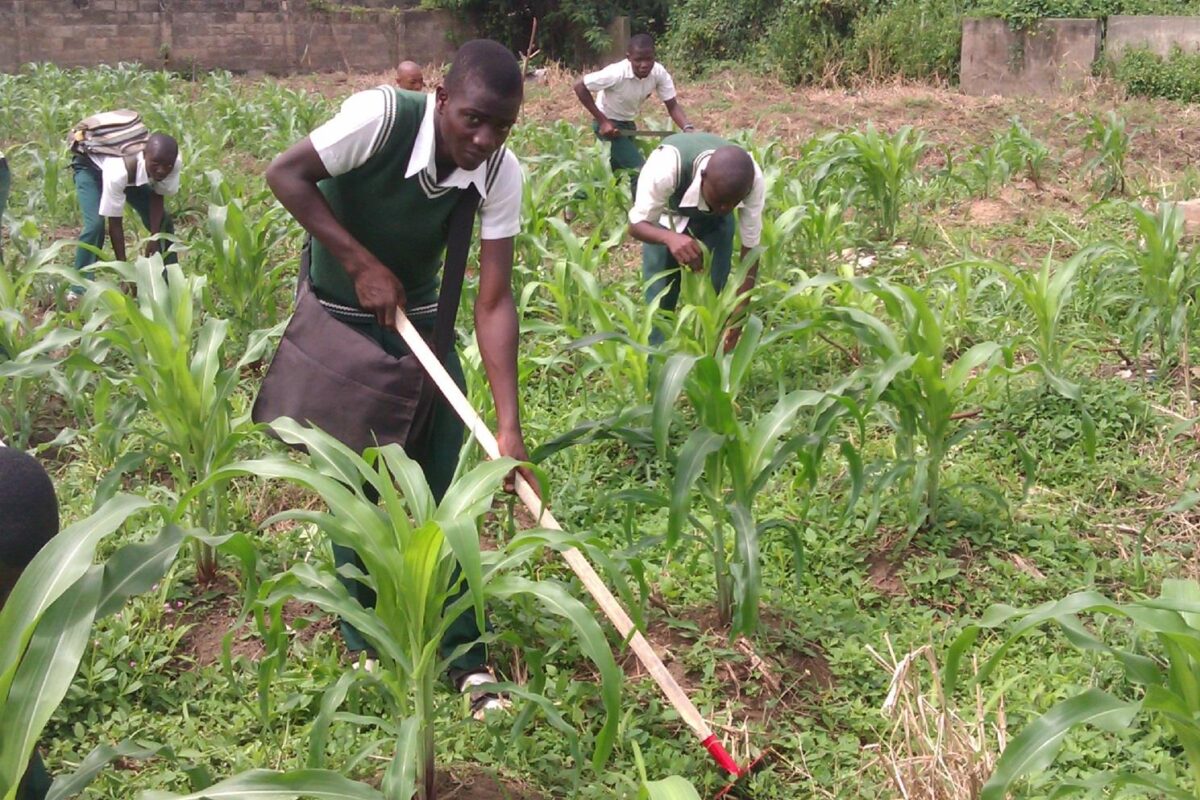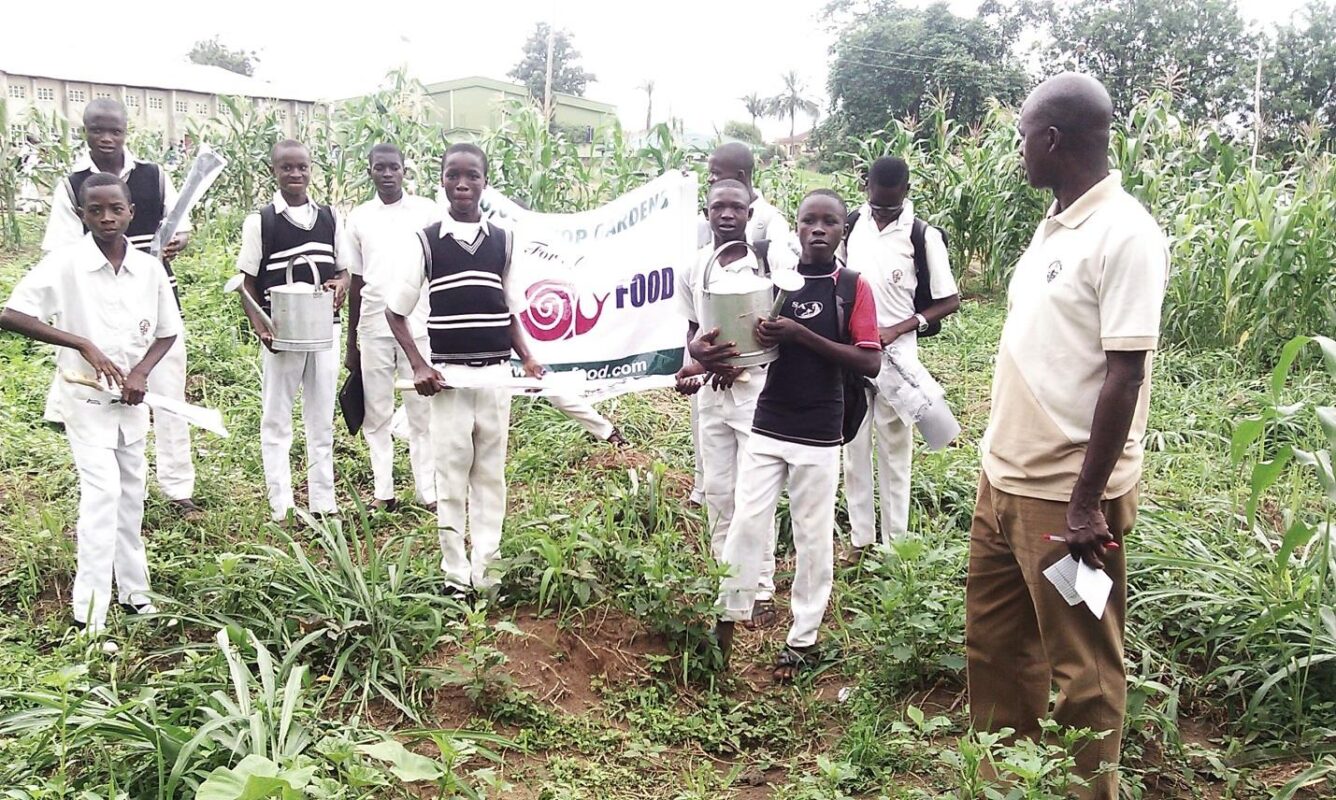WWOOF NIGERIA SCHOOL GARDENS PROJECT
The Garden Project Is Being Supported And Sponsored By Slow Food Foundation For Biodiversity,Italy.
For the village school garden project, we have a designed template which we used and follow to do this; the adopted template is illustrated below:
School garden essentials
The WWOOF school garden project embodies the principles of organic Manifesto.
More precisely,
- cultivates good, clean, fair, and healthy food
- cultivates pleasure as a key teaching tool
- protects biodiversity and conserves resources (soil, water, air, seeds)
- protects diversity, because each garden is unique, an expression of the environment and the culture in which it develops expresses all its potential as part of a learning community, drawing vitality from the skill and passion of the people who tend it (producers, families, cooks, grandparents with green fingers etc.)
- Promoteshealth and integration by developing a culture of food (knowledge, sensory education, traditions, the food-mind relationship, labeling, migrations etc.)
- is part of an international network

ALUGBO COMMUNITY SCHOOL

ST PETER SCHOOL , REMO SAGAMU

AQUINASS COLLEGE, ONDO

OYEMEKU GRAMMAR SCHOOL GARDEN, ONDO
The aims of a school food garden
- To develop food and environmental education in schools
- To promote the concept of good, clean, fair and healthy food
- To develop awareness of eating as a cultural fact
- To develop natural and cultural diversity, in the field, in the classroom and at the table
- To build a learning community
- To promote knowledge of the local area, its biodiversity, its produce and recipes by providing opportunities to meet with experts (artisans, producers, cooks)
- To let children carry out open-air activities to round off their classroom studies
- To involve children in food cultivation, gathering, preparation and consumption
- To introduce multidisciplinary teaching, in which the garden becomes a learning tool
- To acquire an inductive methodological approach to food and environmental education by developing teaching experiences in the classroom and the garden
- To develop inclusive teaching courses to valorize all the children’s skills
- To improve memory and capacity for sensory perception, and learn the vocabulary and grammar of taste
- To develop critical sensibility and acquire the tools to become mindful citizens
- To spread knowledge of jobs in the agricultural and food sector, that of the farmer first and foremost
- To consolidate an international school garden network to exchange experiences and good practices.
THE AGRONOMIC RULES OF A FOOD GARDEN
The organic garden is eco-friendly.
- It adopts crop-growing techniques that adapt to the specific nature of the local area
- It uses water as a resource to be protected, and thus deploys techniques such as drip irrigation and mulching
- It cultivates native species of many different varieties
- It conserves and reproduces its own seeds
- t defends itself from parasites and fungi without the use of chemicals
- It defends soil fertility through consolidated practices such as crop rotation, green manure plant cultivation, mulching and the spreading of self-produced compost
Below is a list of the experiences common to each level of school. The various activities should be organized according to the age of pupils.
- Building the garden, from the evaluation and design of the space available to the harvesting of the produce
- The garden as a teaching tool, the organization of a multidisciplinary experience
- The garden as a way of protecting biodiversity: the cultivation of different local varieties, protection of the life of the soil, the conservation and exchange of local seeds, the construction of an environment that welcomes bees and other pollinators, the preservation of wild herbs
- A learning community and a way of protecting biodiversity: mapping of the produce grown in neighborhood gardens, visits to producers, collaboration with the nodes of the Slow Food Travel network, intercultural exchange through food, Taste Workshops for children and their parents, sensory education activities for children and their parents, inheritance of knowledge from grandparents with green fingers, research on local recipes and family traditions
IN ORGANISING THE GARDEN, FOLLOWING STEPS NEED TO BE CONSIDERED
PLANNING:
- identify the space to turn into a garden
- find out if permits are needed to use outdoor spaces
- prepare the water point
- check that the space enjoys suitable exposure to sunlight
- identify grandparents with green fingers
- prepare planter boxes if the school is without enough outdoor space
- plow the soil
- schedule sowing and grafting
INVOLVING THE PUPILS:
- ask the pupils to imagine the garden and draw it
- collect and display the drawings
- choose the best
- choose the shape and size of the vegetable beds
- choose the vegetables to be grown
- collect seeds and seedlings, giving priority to local varieties
BUILDING
- mark the boundaries of the vegetable beds
- ensure that the beds are easily accessible for the children (maximum width 80 cm-1 m)
- sow the seeds
- prepare labels to mark the beds sown
- tend the crops
- water the crops
- weed the beds
- carry out any grafting work
- be sure to consociate “friendly” crops
- set up supports for crops that need them (e.g., poles for tomatoes)
- plant flowers in the garden to attract pollinator insects and bees
- harvest the vegetables when they are ripe
- eat the food grown together
GARDEN EXPERIENCE on one portion of soil:
- explore the soil all over
- observe color, texture and temperature
- Take note of other elements (pebbles, leaves, bits of wood etc.)
- Identify the soil type (clayey, sandy, mixed etc.)
SOIL AS A LIVING ENVIRONMENT
Subjects to address in the classroom and in the garden:
- insects and small animals that live in the garden
- worms and the fundamental role they play for the soil
- the larvae and other tiny creatures that hide in the soil
- the precious invisible life forms that make the soil fertile (bacteria, microorganisms and decomposers)
COMPOST
The garden is an ecosystem that generates no refuse: waste from one species becomes food for another:
- build a composter in the garden
- select what to compost
- collect garden cultivation and cafeteria waste
- manure the garden with the compost
- introduce the basic principle of ecology: namely that matter circulates constantly in the web of life.
SOIL FERTILITY
Subjects to teach in the classroom and in the garden:
- the four elements (air, water, fire, earth)
- care for the soil to keep it fertile (it should be loose, well-aerated, moist to the right degree, covered with mulch etc.)
- small experiments to determine the composition of the soil (sandy, clayey, mixed)
- the fertile portion: humus
- how to restore fertility to the soil: compost and green manure.
THE GARDEN AS ECOSYSTEM, an eco-friendly garden is a test bed of biodiversity:
- cultivate local varieties
- sow different varieties of the same vegetable
- plant “friends” and plant “enemies”: consociations
- sow vegetables with different edible parts: i.e., leaves, roots, fruits
- plant flowers to attract pollinators and bees
- Plant flowers and herbs that act as a natural defense against plant parasites (French marigold, nasturtium, garlic, lavender etc.)
GERMINATION:
- easy experiments to determine what seeds need to sprout and grow: water yes/no, light yes/no, warmth yes/no, soil yes/no (beans: observation of the growth from seed to plant)
- observe and discuss with the pupils
SOWING AND GRAFTING:
- sow seeds in different ways according to type and future plant (broadcast, in furrows)
- plant bulbs and tubers graft schedule sowing and grafting according to the seasons
- Organize tending of the garden in periods when school is out.
FAIRNESS
Finally, the spirit of fairness is very essential in WWOOF School organic garden project, the garden must be served as avenue to punish the pupil, every pupil that contributed to the building and cultivation of the garden must also have their share at harvest.
